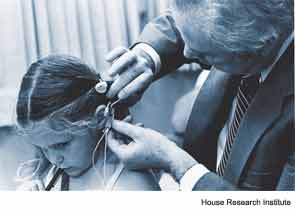Explore This Issue
April 2013
The Fruitful 1970s
Major advances were made in the 1970s, and three of the top investigators were located in California, said Dr. John House. Robin Michelson, MD, working at the University of California San Francisco (UCSF), was also forging ahead, collaborating with C. Robert Pettit, MD, neurophysiologist Michael Merzenich, PhD, and later Storz electrical engineer Mel Bartz, to develop a gold two-electrode system. At the House Ear Institute, Dr. William House and his collaborators produced the first wearable device and the first induction system, featuring a centering coil and an attaching magnet, in 1972.
The multi-electrode strategy gained prominence in the early 1970s due to the work of French otologist Claude-Henri Chouard with the Institut National de la Sante’ et de la Recherche Scientifique in Paris, who had been a student of Eyriès. In 1973, he devised a procedure to implant electrodes through 12 separate openings into the cochlea, thus exploiting the pitch particularity of each section of the hair cell-lined cochlea. In Melbourne, Australia, a team led by Graeme Clark was also working through the 1970s, developing a multi-channel prototype with an array of 20 electrodes; their first successful implantation took place in 1978. Yet another group, working in Vienna, designed and manufactured a passive single-channel broadband analog implant. The Australian efforts coalesced into Cochlear Ltd.; the Austrians’ work became today’s MED-EL.
Scientific Community Pushback
All of this activity resulted in the First International Conference on Electrical Stimulation of the Acoustic Nerve, held in 1974 at UCSF. Investigators on teams from institutions such as HEI, Stanford and UCSF had been collecting evidence on film of their patients perceiving sound for the first time. Still, many in the scientific community were not convinced of the efficacy of implantation, including Harold Schuknecht, MD, chief of otolaryngology at Massachusetts Eye and Ear Infirmary in Boston, who said at the conference: “I interpreted the movies and the case presentations to confirm my suspicion that the prostheses as they are now designed are of very little use.”
Dr. William House was undeterred, and in 1977 devised a new strategy to bring CIs to market. He told Dr. Miyamoto, “The scientists won’t listen to us, but if something good happens for patients, they’re going to have to listen to them.” He hoped the multi-center study would provide definitive proof that patients were benefitting from the procedure. Dr. Miyamoto agreed with this concept.
Leave a Reply